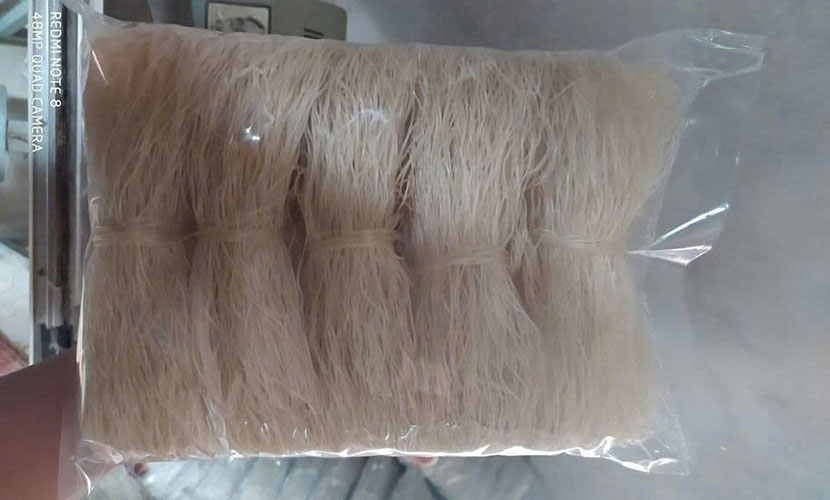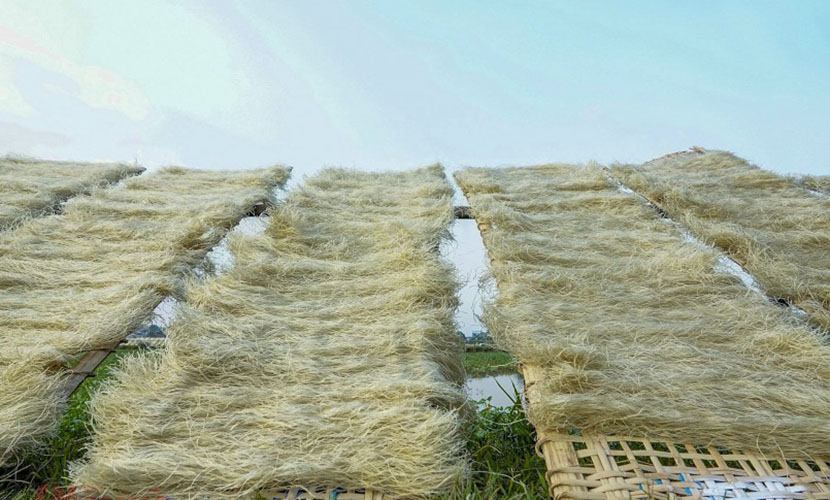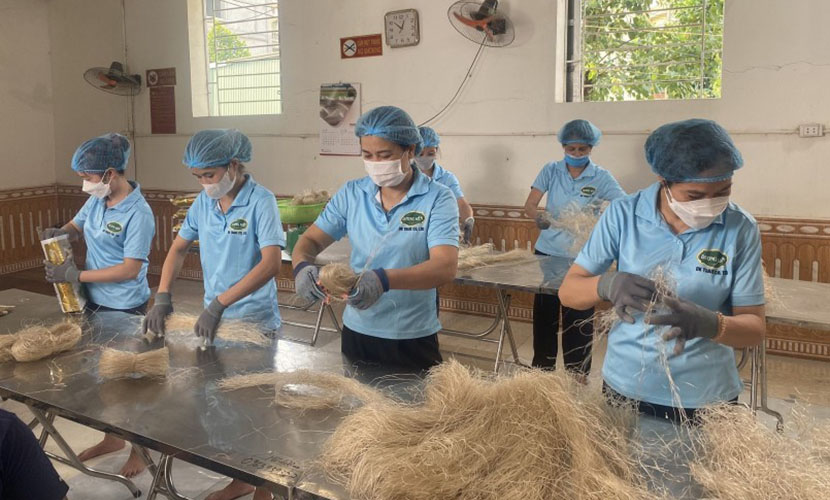
For every Vietnamese person, a dish made from glass noodles is an indispensable part of the Lunar New Year. To have a fragrant bowl of canna noodles during these holidays, consumers often choose products from traditional craft villages. Among them, Lang So canna noodles (miến dong Làng So) stand out for their high quality and authentic traditional flavor.
Lang So or So Village belongs to Tan Hoa commune, Quoc Oai district, Hanoi. The villagers no longer remember exactly when the craft of making glass noodles began. They only know that it was a traditional profession passed down from their ancestors.
According to the elders, the name “Lang So glass noodles” has related to the So Communal House. This communal house is one of the most ancient and well-known in the area.

Lang So canna noodles
So Village is surrounded by four mountains named Long, Ly, Quy, and Phuong, all covered in lush greenery. Nature has gifted the area with a clean, sweet groundwater source. This is a key factor contributing to the clarity and unique taste of Lang So canna noodles here.
Mr. Ty is a longtime glass noodle producer in Tan Hoa commune. According to him, local villagers use 100% starch from the canna plant (cây dong riềng) to make high-quality noodles. They soak the starch several times to remove sand and impurities. After three rounds of filtering, it yields pure starch.
Farmers cook a small amount and mix with raw starch to prevent settling. Then, they steam mixture into sheets and dry in the fields for 90–180 minutes, depending on the weather.
Interestingly, the villagers make the drying process against the wind to ensure even and fast drying. Afterthat, they cut and briefly soak in water to soften. Then, they shape into strands and dry again for about three hours before being bundled and packaged.

Lang So canna noodle bag
So Village produces noodles year-round. However, the main production season of Lang So canna noodles runs from September to December. Due to rising market demand and the need to save labor, many households have invested in semi-automatic machinery. This allows them to achieve an average daily output of 3,000–4,000 kg of noodles.
Therefore, Lang So canna noodles are naturally clear white, elastic yet crispy, and maintain their shape without becoming mushy or sticky when overcooked. They are completely free from preservatives and additives.
Today, Lang So canna starch noodles are not only available across Vietnam. They are also available in international markets such as Japan, South Korea, and Germany.
In recent years, Lang So canna noodles have frequently participated in major agricultural and industrial trade fairs and exhibitions. The high quality and reliability of the product have earned strong consumer trust. This is a positive sign and a motivation for local producers to preserve and promote the traditional brand of their homeland.
Glass noodle production has not only helped preserve the village’s cultural heritage. It has also brought higher economic returns compared to traditional farming. In addition, this has generated stable incomes and job opportunities for local workers.

Drying Lang So canna noodles
According to Mr. Duc, Chairman of Tan Hoa Commune, about 65 households have related to glass noodle production. The income from this profession is significantly higher than that from rice farming. For example, a rice paper steamer earns around 400,000 VND per day.
Meanwhile, workers performing simpler tasks earn more around six million VND per month. On average, each person earns about 62 million VND per year. Each household business typically employs around 20 workers.
Mr. Duc also noted that over one-third of the 65 noodle-making households have obtained OCOP (One Commune One Product) certification. During the days leading up to Tet holidays, the commune produces an average of 200 tons of glass noodles per day.
Lang So canna noodles have full registered information with barcodes, trademarks, and food safety certifications. The product quality is publicly declared nationwide in accordance with regulations. As a result, they have earned widespread trust and support from consumers.
Locals in the Doai region even have a saying: “A royal feast is incomplete without Lang So canna noodles”. It underscores just how famous this delicacy is.

Lang So canna noodle facility
What makes Lang So canna noodles unique is their use of 100% pure canna root starch (tinh bột dong riềng). It has sourced from plants that thrive along the banks of the Day River. The clean underground water filtered through layers of laterite rock contributes to the noodles’ clear color and taste. To create premium-quality noodles, the villagers have selected the best canna roots only.
From ingredient selection to processing, the villagers are meticulous, preserving their ancestral noodle-making techniques to maintain the product’s uniqueness. Although the villagers use machinery increase productivity and ease labor, the core stages of the process remain carefully done by hand. Also, the local government has also been actively supporting the villagers in maintaining this traditional craft.
“We are working with district-level authorities to control raw material sources. We are also proposing the establishment of the Tan Hoa Industrial Cluster so that production can be centralized. This will make quality control and waste management more efficient,” said Mr. Duc.
Once carried by village women to rural markets, Lang So canna noodles have now become a nationally recognized brand. Today, local producers utilize online platforms to promote their products and expand their reach.
Vietnamese source: https://thuonghieusanpham.vn/mien-dong-lang-so-thom-thao-mam-co-tet-co-truyen-47470.html
